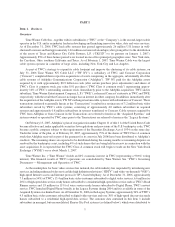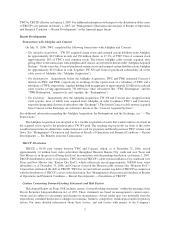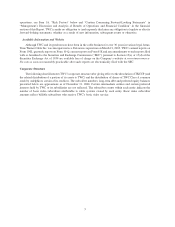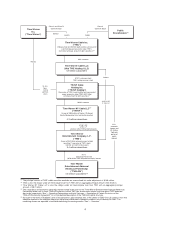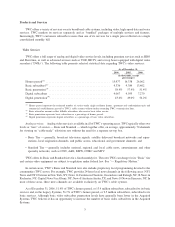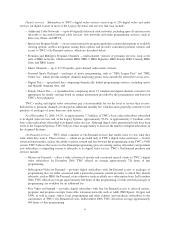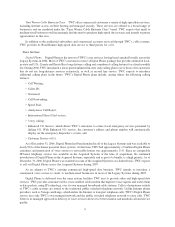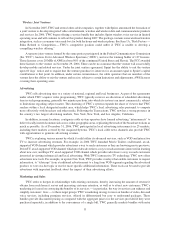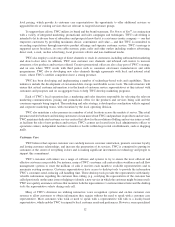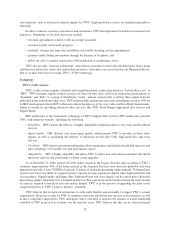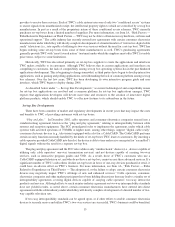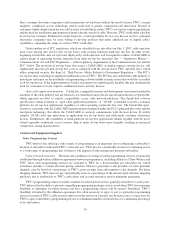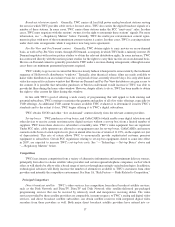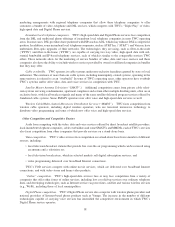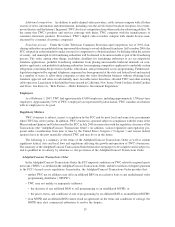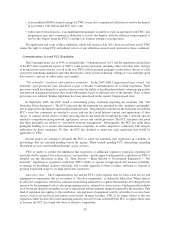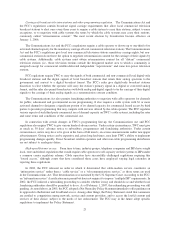Time Warner Cable 2006 Annual Report Download - page 16
Download and view the complete annual report
Please find page 16 of the 2006 Time Warner Cable annual report below. You can navigate through the pages in the report by either clicking on the pages listed below, or by using the keyword search tool below to find specific information within the annual report.Wireless Joint Ventures
In November 2005, TWC and several other cable companies, together with Sprint, announced the formation of
a joint venture to develop integrated video entertainment, wireline and wireless data and communications products
and services. In 2006, TWC began offering a service bundle that includes Sprint wireless voice service in limited
operating areas and will continue to roll out this product during 2007. The package contains some wireline/wireless
integration, such as a common voice mail-box for both the home and wireless phone. See Item 1A, “Risk Factors —
Risks Related to Competition — TWC’s competitive position could suffer if TWC is unable to develop a
compelling wireless offering.”
A separate joint venture formed by the same parties participated in the Federal Communication Commission
(the “FCC”) Auction 66 for Advanced Wireless Spectrum (“AWS”), and was the winning bidder of 137 licenses.
These licenses cover 20 MHz of AWS in about 90% of the continental United States and Hawaii. The FCC awarded
these licenses to the venture on November 29, 2006. There can be no assurance that the venture will successfully
develop mobile and related services. Under the joint venture agreement, Sprint has the ability to exit the venture
upon 60 days’ notice and to require that the venture purchase its interests for an amount equal to Sprint’s capital
contributions to that point. In addition, under certain circumstances, the cable operators that are members of the
venture have the ability to exit the venture and receive, subject to certain limitations and adjustments, AWS licenses
covering their operating areas.
Advertising
TWC sells advertising time to a variety of national, regional and local businesses. As part of the agreements
under which TWC acquires video programming, TWC typically receives an allocation of scheduled advertising
time in such programming, generally two minutes per hour, into which its systems can insert commercials, subject
to limitations regarding subject matter. The clustering of TWC’s systems expands the share of viewers that TWC
reaches within a local designated market area, which helps TWC’s local advertising sales personnel to compete
more effectively with broadcast and other media. Following the Transactions, TWC now has a strong presence in
the country’s two largest advertising markets, New York, New York, and Los Angeles, California.
In addition, in many locations, contiguous cable system operators have formed advertising “interconnects” to
deliver locally inserted commercials across wider geographic areas, replicating the reach of the broadcast stations as
much as possible. As of December 31, 2006, TWC participated in local advertising interconnects in 23 markets,
including three markets covered by the Acquired Systems. TWC’s local cable news channels also provide TWC
with opportunities to generate advertising revenue.
TWC is exploring various means by which it could utilize its advanced services, such as VOD and interactive
TV to increase advertising revenues. For example, in 2006 TWC launched Movie Trailers on-Demand, an ad-
supported VOD channel which provides advertisers a way to reach customers as they are browsing movie previews;
DriverTV, an ad-supported VOD channel which provides advertisers a way to reach customers interested in learning
about new cars; and Expo TV, an ad-supported VOD channel which provides advertisers a way to reach customers
interested in viewing infomercial and local advertising. With TWC’s interactive TV technology, TWC now offers
advertisers new tools. For example, in upstate New York, TWC provides overlays that enable customers to request
information, to “telescope” from a traditional advertisement to a long form VOD segment regarding the advertised
product, to vote on a hot topic or receive more specific additional information. These tools can be used to provide
advertisers with important feedback about the impact of their advertising efforts.
Marketing and Sales
TWC seeks to deepen its relationships with existing customers, thereby increasing the amount of revenue it
obtains from each home it serves and increasing customer retention, as well as to attract new customers. TWC’s
marketing is focused on conveying the benefits of its services — in particular, the way its services can enhance and
simplify customers’ lives — to these target groups. TWC’s marketing strategy focuses on bundles of video, data and
voice services, including premium services, offered in differentiated but easy to understand packages. These
bundles provide discounted pricing as compared with the aggregate prices for the services provided if they were
purchased separately, in addition to the convenience of a single bill. TWC generally markets bundles with entry
11


